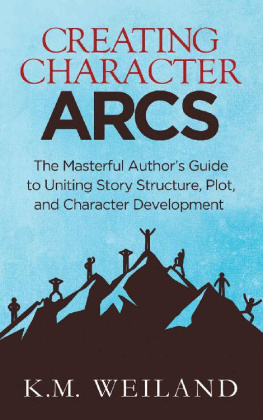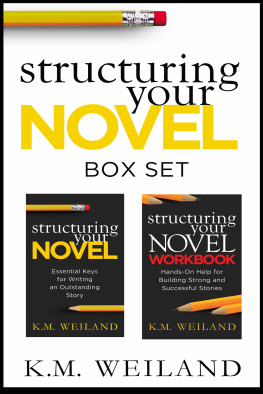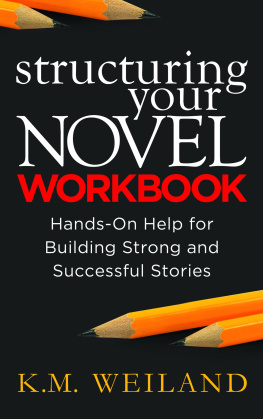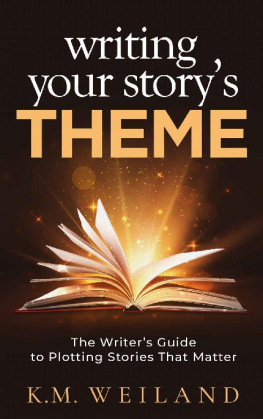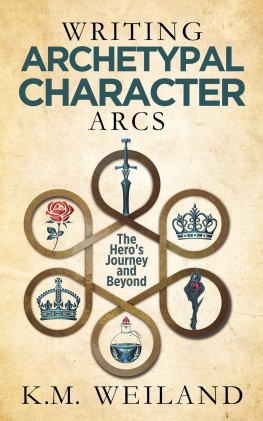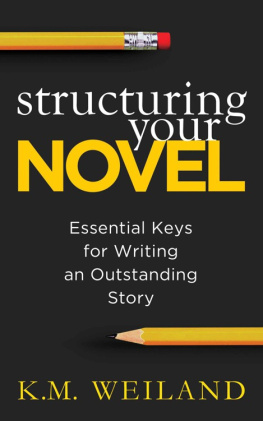Contents
CREATING CHARACTER ARCS
The Masterful Authors Guide to Uniting Story Structure, Plot, and Character Development
K.M. Weiland
PenForASword Publishing

Get a free copy of acclaimed author K.M. Weilands helpful book of character tips CRAFTING UNFORGETTABLE CHARACTERS.
Click here to get started:
https://www.kmweiland.com/free-characters-book/
Powerful Character Arcs Create Powerful Stories
Have you written a story with an exciting concept and interesting charactersbut it just isnt grabbing the attention of readers or agents? Its time to look deeper into the story beats that create realistic and compelling character arcs. Internationally published, award-winning novelist K.M. Weiland shares her acclaimed method for achieving memorable and moving character arcs in every book you write.
By applying the foundation of the Three-Act Story Structure and then delving even deeper into the psychology of realistic and dynamic human change, Weiland offers a beat-by-beat checklist of character arc guidelines that flexes to fit any type of story.
This comprehensive book will teach you:
How to determine which arcpositive, negative, or flatis right for your character.
Why you should NEVER pit plot against character. Instead, learn how to blend story structure and character development.
How to recognize and avoid the worst pitfalls of writing novels without character arcs.
How to hack the secret to using overarching character arcs to create amazing trilogies and series.
And much more!
Gaining an understanding of how to write character arcs is a game-changing moment in any authors pursuit of the craft.
Bring your characters to unforgettable and realistic lifeand take your stories from good to great!
Introduction
Can You Structure Characters?
WHAT IF THERE were a sure-fire secret to creating stunning character arcs? Would you be interested in discovering it? If you care about connecting with readers, grabbing their emotions, and creating stories that will resonate on a level deeper than mere entertainment, then the answer has to be a resounding yes!
But heres the thing about character arcs: theyre way too easy to take for granted. On the surface, character arcs seem to boil down to nothing more than a simple three-step process:
The protagonist starts one way.
The protagonist learns some lessons throughout the story.
The protagonist ends in a (probably) better place.
Thats character arc in a nutshell. Easy-peasy, lemon squeezy. Whats to learn?
Turns out: a lot.
The Link Between Character Arcs and Story Structure
Too often, character and plot are viewed as separate entitiesto the point that we often pit them against each other, trying to determine which is more important. But nothing could be further from the truth. Plot and character are integral to one another. Remove either one from the equation (or even just try to approach them as if they were independent of one another), and you risk creating a story that may have awesome parts , but which will not be an awesome whole .
We often think of plot as being about structure, but our notions of character and character arc tend toward the more airy-fairy. Surely, character arc is something that must evolve organically from the characters themselves. Surely, we cant structure our character arcs without making them formulaic or robbing them of life and spontaneity.
Surely, right?
Wrong, actually. When we say plot and character are integral to one another, what were really saying is that plot structure and character arc are integral to one another. In his classic guide Story , Robert McKee says:
We cannot ask which is more important, structure or character, because structure is character; character is structure. Theyre the same thing, and therefore one cannot be more important than the other.
If youre familiar with the basics of story structure (such as I talk about in my book Structuring Your Novel ), then you can probably already see some of this structuring of character arc in action. The Major Plot Points all revolve around the characters actions and reactions. As Michael Hauge says in Writing Screenplays That Sell :
The three acts of the [story] correspond to the three stages of the heros outer motivation. Each change in the heros motivation signals the arrival of the next act.
The character drives the plot, and the plot molds the characters arc. They cannot work independently.
The Link Between Character Arcs and Theme
But it gets better! Not only does character arc directly influence story structure, it is also a direct influence on theme. In some respects, we might even go so far as to say that character arc = theme.
On even the surface level, the discovery of the integrality of these three most important of all story elements is thrilling. None of them lives in a vacuum. They are all symbiotic.
This makes the creation of all three both a little more complicated and, at the same time, a whole lot easier. Its more complicated for the obvious reason that we have three times as many story elements to keep track of at once. But it simplifies the overall process by rolling all three into a cohesive whole. Once you understand how plot, character, and theme all work together, chances are good that, if you get one of them right, youll get all three right.
The Three Basic Character Arcs
Although the possibilities for character development are as endless as the vagaries of human nature, we can narrow character arcs down to three basic types, with a few primary variations upon each:
The Positive Change Arc
This is the most popular and often the most resonant character arc. The protagonist will start out with varying levels of personal unfulfillment and denial. Over the course of the story, he will be forced to challenge his beliefs about himself and the world, until finally he conquers his inner demons (and, as a result, probably his outer antagonists as well) and ends his arc having changed in a positive way.
The Flat Arc
Many popular stories feature characters who are already essentially complete unto themselves. Theyre already heroes and dont require any noticeable personal growth to gain the inner strength to defeat the external antagonists. These characters experience little to no change over the course of the story, making their arcs static or flat. These characters are the catalysts for change in the story world around them, sparking prominent growth arcs in the minor characters.
The Negative Change Arc
Negative Change Arcs offer, arguably, more variations than either of the other arcs. However, at their most basic level, the Negative Change Arc is just a Positive Change Arc flipped on its head. Instead of a character who grows out of his faults into a better person, the Negative Change Arc presents a character who ends in a worse state than that in which he began the story.
Because the Positive Change Arc is both the most complicated of the three arcs and the most integral to understanding the other two arcs, well be spending the largest section of the book discussing the intricacies of how to evolve your character in a positive way.
How should you create your characters arcs? Where do you find their foundation? How do the important moments in story structure affect (and are affected by) the important moments in character arc? In short, how does character arc work ? And how can you crack the code and create a stunning character arc in every single story? Read on to find out!
Part 1: The Positive Change Arc
Chapter 1
The Lie Your Character Believes

